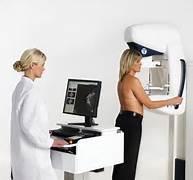When doing presentations on breast cancer awareness, I find that most of the women in the audience do not know the difference between the standard mammogram, that has been around for decades, and a digital mammogram, a newer way of screening, that uses computers.
X-rays have been used for nearly a century to detect breast cancer. But the modern-day film mammogram was invented in 1969. In this procedure, images are recorded on film much in the way a traditional film camera takes pictures. In a digital mammogram, X-rays are still used. However, they are turned into electric signals that can then be stored in a computer. This is similar to the way digital cameras take and store pictures.
While film mammograms are very effective, some research suggests that they may miss between 10% and 20% percent of breast cancers.
Fifteen years ago, a mammogram using recorded images of my breast on film showed something suspicious for cancer. The path report results…a 1.9 centimeter invasive ductal carcinoma in my right breast. Four years ago, a digital mammogram found a 9 millimeter invasive ductal carcinoma in my left breast.
A study published in the New England Journal of Medicine compared digital mammograms to film mammograms. The study involved 49,000 women in North America with no known signs of breast cancer. The women were screened using both digital and film mammograms at the beginning of the study and again one year later. Breast cancer was found in 335 of the women. The researchers determined that digital mammograms were superior to film mammograms for four groups:
- Women under 50 years of age
- Women with dense breasts
- Women over 50 with dense breasts
- Women who have not yet gone through menopause, or in menopause less than one year.
While the study did not state whether the increased use of digital mammography over film mammography would result in fewer deaths, the researchers did state that the types of cancer caught by digital mammograms, after being missed on film, are forms of the disease that can be fatal.
So, when it is time for your next mammogram…make it a digital.
Sources: New England Journal of Medicine, WebMD


